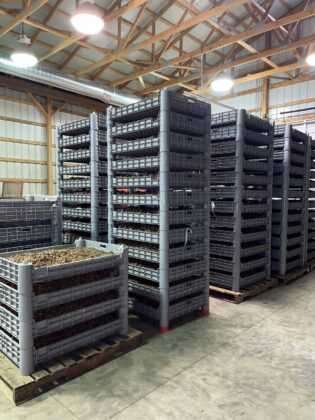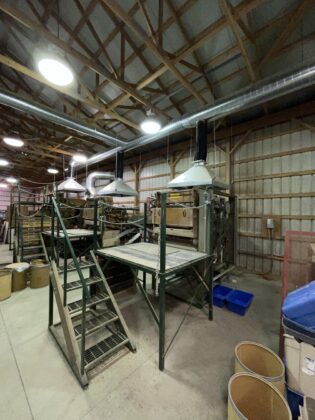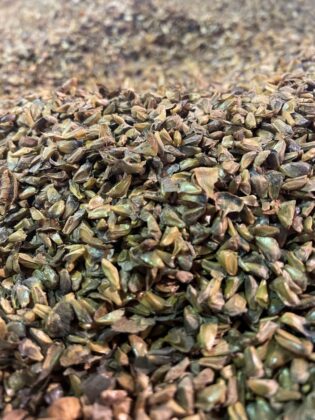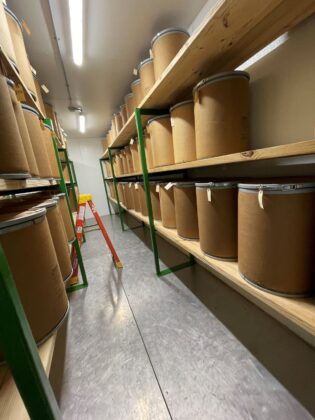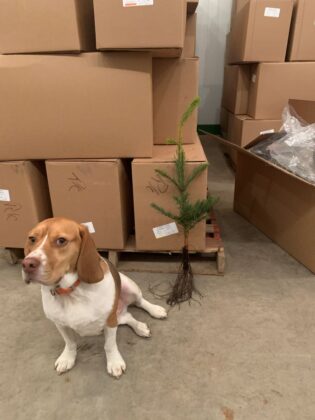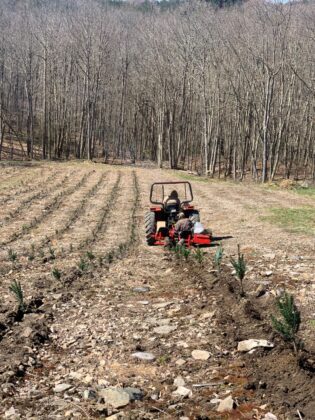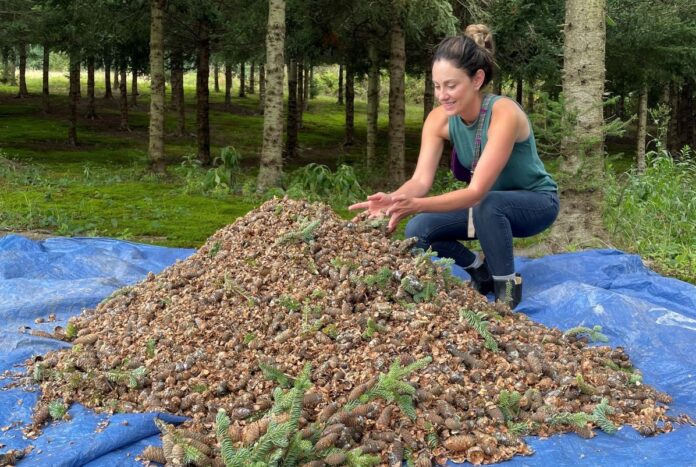
SMITHFIELD, Pa. — In January, when most people are putting ornaments away and sweeping up discarded needles, Jim Rockis is still thinking about Christmas trees. He thinks about them every day, all year long.
He owns Quarter Pine Tree Farm and Reliable Source Seeds & Transplants. The tree farm is where he sells live Christmas trees to people through the holiday season. Through Reliable Source, he sells seeds, seedlings, transplants and trees.
Christmas trees began as a way for Rockis to pay for the farm, but it soon became much more as he realized his passion for the industry. It’s one where much of the hard work won’t be realized by Rockis himself.
“It takes seven years until you get a crop that you can sell,” said Beth Bossio, Rockis’s stepdaughter. That’s for cut trees planted in a tree farm. A rule of thumb is that it takes a tree about 20 years before it is mature enough to produce progeny.
“On the seed orchard aspect, with the stuff Jim is talking about with me and my brother… he knows that time he will not be physically here to see the fruit of his labor,” Bossio said.
Busy seasons
The holidays may seem like the busiest time of year, and no doubt, they are busy then. In addition to pre-cut trees, visitors can also go out in the fields and cut down their own.
The next busy period is coming up soon. Right now, Rockis’ business partner in Washington is lifting young trees from transplant beds, packing them together in boxes and freezing them. This keeps them in a dormant state until they are ready to be planted to tree farms along the East Coast.
Several shipments have already arrived at Rockis’ warehouse, with several more coming. The trees stay boxed up in freezers until the end of March. That’s typically when customers with farms in Connecticut and Rhode Island are ready to plant. Rockis and his son, Will, deliver the transplants to each of their customers.
“The ocean tempers the weather up there and those guys are ready to plant before anyone else,” Rockis said. “Then we just follow the weather patterns. People in Maryland and Pennsylvania. We go up into New York. There’s a couple areas in New York that are really cold. We usually take stuff up there the third week of April.”
Rockis and his son, Will, deliver the transplants to each of their customers.
“We spent a lot of time trying to make sure there’s no break in the chain,” he said. “We try to do a lot of this stuff ourselves, like the deliveries. Then, I know how the material is handled. I get to stop and talk with different growers.”
Late summer is another busy time. That’s when trees are sheared, and pine cones are harvested. Trees don’t always produce cones each year. Sometimes it’s every other year, or every third year.
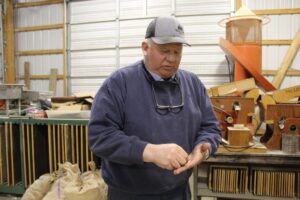
Rockis visits his seed orchards, of which there are more than a dozen spread throughout Pennsylvania and West Virginia, in August, to see which ones are producing and collect the cones. He also has access to seed orchards owned by other farmers in New York and North Carolina.
The cones are dried through the fall and processed after the holidays to extract the seeds.
Partnerships
Rockis bought the farm from his great aunt. It was a typical subsistence farm. Rockis said he helped out on the farm growing up. When it came time to get her estate in order, his great aunt asked if he was interested in buying it.
“She made it financially so that I could purchase it,” he said. “I thought ‘What can I do with this land to help pay for it?’ I had to pay my aunt back. I had to come up with something.”
Christmas trees were it. He started out planting trees. Then, he became interested in genetic development. He started processing seeds. From his research and breeding projects, Rockis ended up with extra seed. He started selling it around the region. That expanded to most of the East Coast. Soon, he was shipping seed across the country to the Pacific Northwest.
That’s how he connected with Kenny Scholz, who ran a transplant nursery in Washington. The two partnered to grow transplants. The ground in that part of Washington doesn’t freeze as hard as it does in the northeast, making it an ideal place to start, grow and transplant coniferous trees.
“You lift the trees when they’re in a real deep dormancy,” he said. “Raising trees out here, you can’t lift them because the ground is frozen solid 6-8 inches down.”
The trees are started in greenhouses and grown there for 26 weeks. Then they are planted in transplant beds, where they’ll stay for a growing season or two.
Christmas trees are about 3 years old when they are delivered to farms by Rockis and put in the ground by his customers.
Genetic work
As Rockis was coming up in the industry, he connected with Franklin Cech, a forestry professor at West Virginia University, who was involved with quantitative genetics. Rockis started working with Cech to improve the Canaan fir, a tree similar in appearance to the highly-sought after Fraser fir but native to certain regions of West Virginia.
“The Fraser fir is probably the most predominant, sought-after tree,” Rockis said. “We couldn’t grow it in this area. The elevation is too low. The climate and soils aren’t quite right. But this Canaan fir, it will grow here.”
The Canaan fir might also grow well in other areas where the Fraser fir does not. This meant going out in the woods to find Canaan firs, which grow naturally in the Canaan Valley in eastern West Virginia, to collect pine cones from the wild trees.
“What you want to do is try to find trees in nature that have qualities you’re looking for,” he said.
Then they created seed orchards where desirable trees are bred with one another to create even better trees. At least that’s the goal.
Rockis owes much of his passion and knowledge to Cech, he said. He passed away 15 years ago.
”I’d say almost every day that I work with Jim, Frank is brought up in conversation,” Bossio said.
“I’m really missing him, because I’m ready to take it to the next level and I need his help,” Rockis said.
It takes a tree 20 years to mature. That process can be expedited somewhat by grafting scions from mother trees onto rootstock, but it still takes about 10 years from then.
Family business
It takes a couple generations of people to see this genetic work through. Fortunately, Rockis’s children are up for the task of carrying on his work.
Will Rockis has a degree in horticulture from Washington State University. He worked at tree farms and seed processors out west before returning to the family farm.
“Will does a better job at processing seed than Jim does,” Bossio said.
“Oh, yeah, he does,” Rockis confirmed.
Bossio has worked for the farm part time for years, but came back full time in the last couple years. She’s learning the ins and outs of the seed orchards and helping Jim digitize his record-keeping. He’s not a computer guy, but he admits it’s much easier to keep track of everything and organize it on an Excel spreadsheet than on giant sheets of paper like he and Cech used to do.
Before the farm, Bossio worked in communications and marketing. She’s using the experience to grow the farm’s social media presence and its offerings during the holidays at the choose and cut farm.
For example, seeing that families were cutting down small trees to put in children’s rooms but paying the full tree price, she started selling transplants that were planted in pots at a lower price point. It allows young trees in the cut and choose orchard to grow up to their full potential and for families to get what they want for a better price. They can also then watch the trees grow up over the years.
She wants to get more into agritourism at the farm throughout the year, to bring in revenue at different times of the year.
“You’re selling an experience,” she said. “My vision is to see how I can grow that more.”
For Rockis’ part, he’s learning to hand over the reins.
“I’m trying to turn loose,” he said. “Just because I like something doesn’t mean others will like it and vice versa.”
(Reporter Rachel Wagoner can be contacted at 800-837-3419 or rachel@farmanddairy.com.)








